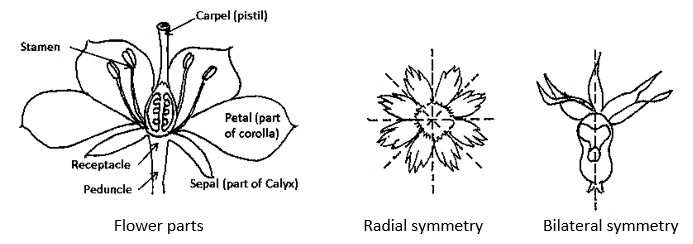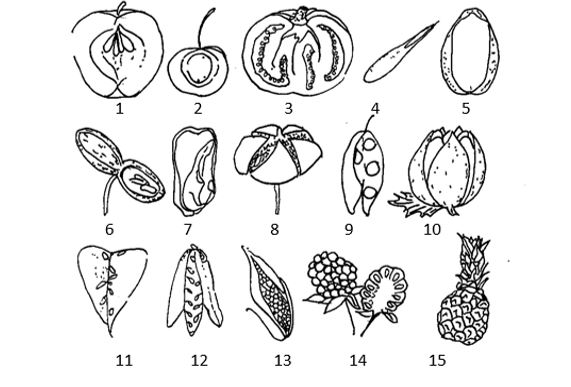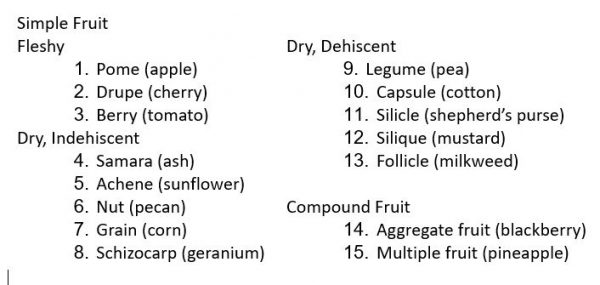PLANT MORPHOLOGY – FLOWERS AND FRUIT
The most significant patterns, in terms of evolutionary relationships, involve reproductive structures, such as the number and arrangement of flower parts, or the structure of cones. While the size and shape of vegetative structures such as leaves and stems are relatively plastic or changeable, the basic patterns of reproductive structures change little over time. Although access to flowers and fruit may be seasonal, digital resources and herbarium samples allow the identification of patterns and relationships within plant taxa.
FLOWER AND INFLORESCENCE MORPHOLOGY
Flower shape, color, and markings are all valuable features for plant identification. Figure 16.1 illustrates some flower shapes that are commonly used for identification purposes.

A typical angiosperm flower is borne on a peduncle (stalk) and is composed of the receptacle, sepals (calyx), petals (corolla), stamens, and pistil (carpel). Flower parts may be fused or separate and usually exhibit radial (star-shaped) symmetry or bilateral (two-mirror image halves) symmetry as shown in Figure 16.2.

In addition to their shape, flowers are often differentiated by further dissections of their structure. For example, complete flowers must have all four main flower parts: sepals, petals, stamens (male) and pistils (female), while incomplete flowers will be missing one or more of these parts. Most flowering plants have perfect flowers that contain both male and female reproductive parts. However, some have imperfect flowers that contain only the male or female part (stamen or pistil) and may or may not contain sepals or petals. A species may have individual plants that are dioecious, producing either male or female flowers or cones on separate plants. Plants that are monoecious produce both female and male flowers and cones on one plant. Flower parts and structures can be examined at this link to Flower Morphology KPU.ca/Hort [PDF] [New Tab][1].
Angiosperms produce flowers which are arranged on a structure called an inflorescence. An inflorescence may support a solitary flower or display individual flowers (florets) to pollinators or expose flower parts to pollen carried on air currents. Figure 16.3 illustrates types of inflorescence commonly found in both woody and herbaceous plants.

Representative characteristics of flowers and inflorescence can be examined at this link to Inflorescence Types KPU.ca/hort [PDF] [New Tab][2].
Fruit Morphology
For the majority of angiosperms, when a flower is pollinated, the pollen joins with an egg to produce a seed. The seed develops within the ovary which is part of the pistil, a female reproductive organ of the flower. The expanded and ripened ovary is referred to as the fruit. Commonly, the enlarged ovary becomes the edible portion of the fruit.
Fruits are classified into one of three main groups: simple, aggregate, or multiple, as shown in Figure 16.4 and Figure 16.5. Simple fruits, which form from a single, ripened ovary, may be either fleshy or dry. Fleshy fruits include the berry (grape), pepo (pumpkin), hesperidium (orange), drupe (plum), and pome (apple). Aggregate fruit develop from a single flower with numerous pistils. Once fertilized, the individual pistils develop into tiny fruitlets clustered on a single receptacle, as in a raspberry or blackberry. Multiple fruits, such as pineapples, form when numerous fertilized flowers in a single inflorescence develop together into a larger fruit.
Dry fruits, are either dehiscent (split open at maturity) or indehiscent (remain closed at maturity). Dry fruits that split at maturity include the legume (pea), silique (mustard), follicle (milkweed), and capsule (cotton). Dry fruits that do not split at maturity include the achene (sunflower), nut (pecan, almond), grain (corn), samara (ash), and schizocarp (geranium, carrot).


In addition to an important feature for identification purposes, many fruit types have decorative value and may provide long season interest in the landscape. The morphology of different fruit types can be examined at this link to Fruit Types KPU.ca/Hort [PDF] [New Tab][3].
For the majority of gymnosperms, the cone is the reproductive structure. Most familiar is the female cone, which is constructed of many small, rounded, scale-like structures attached to a central stem. The pollen bearing male cone is characteristically smaller than the female cone. Typically, a naked seed will develop on each of the scales of a female cone. Examples of recognizable cone characteristics for some closely-related conifers are available at this link to Conifer Cones – Tree Guide UK [New Tab][4].
Comments
Post a Comment